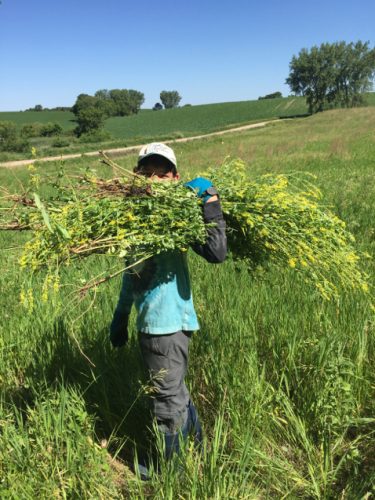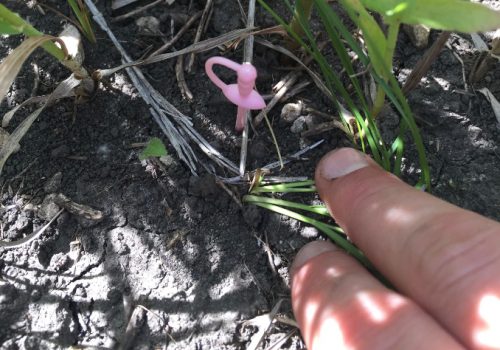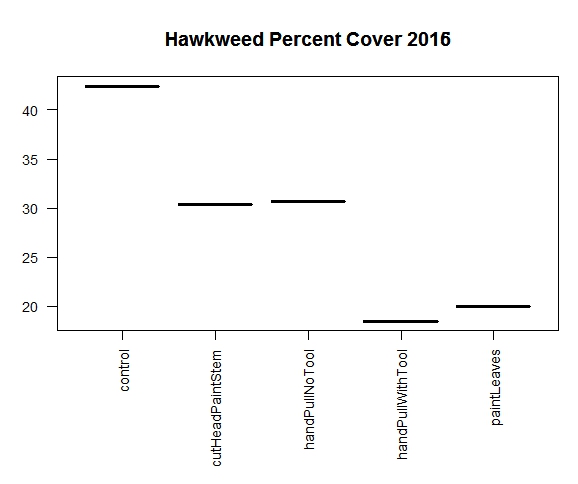It’s raining. We searched for sweet clover south of p1 (experimental plot 1) and pulled about 70 stems. We started walking through p1 and encountered three clumps of bird’s-foot trefoil in rows 31 & 32 near position 878. As we were extracting the three bad plants with garden knives, the skies unleashed a downpour. We hastily gathered the leguminous carnage and headed back to the Hjelm house.
|
||||
|
In 2014, members of Team Echinacea did an experiment to test methods of removing Hawkweed. Last year Ali assessed the results of the different methods that they used: cutting the head and painting the stem with herbicide, painting the leaves with herbicide, hand pulling with and without tools, and a control treatment. You can read her post describing the experiment and with the results from 2015 update here and the original post with methods here. I went back to the treatment plots this morning and assessed Hawkweed percent cover two years after the treatment. The plots with the lowest percent cover this year were those where they removed hawkweed by hand, with tools. These plots also had the smallest percent change from 2015 to 2016, indicating lasting effects of removal. This was in contrast to those that had been treated by painting leaves with herbicide, where plots had an average of 4x increase in Hawkweed. From now on, we’ll use this method to remove Hawkweed in P1. We’ll assess percent cover in the treatment plots and the status of other Hawkweed plants in p1 to keep track of our progress at eradicating Hawkweed from the common garden. Here’s the percent cover data from this year:
The gang had a busy day today, almost all of it in the warm June sun. Alyson continued setting up her experimental plots in the Staffanson bog, and spent the afternoon measuring canopy cover and soil pH for her IS project. Meanwhile, the rest of the team (minus Gretel, who was setting up work for q2 juvenile counts) picked up our fleg begs and counted Hesperostipa spartea and weeded in p1. Amy and James found one H. spartea specimen with 137 seeds! We are now up to 17 out of 59 rows surveyed. Meanwhile, Will, Alex and Per led the crew in weeding out the non-native yellow sweet clover (Melilotus) from the periphery of the plot area. Hopefully we eliminated a lot of potential seeds form the seed bank, meaning that in future years the rows will be devoid of this weedy legume and the study Echinacea will have less competition. Stuart also showed me what poison ivy looks like for the third time, and I still don’t think I could pick it out of a lineup.  Per with a bundle of sweet clover picked from around p1. This is probably less than 10% of what was removed today. After some brief (or for Alex, who was cleaning the bathroom, not so brief) chores at the Hjelm House, the team returned to exPt8 (experimental plot 8) to search for juvenile Echinacea crosses planted in 2013. This meant more time bent over, although now instead of looking for seedlings we were looking for melted bits of toothpick (which were placed to mark seedlings). Some seedlings were in great shape — Alex and I found a couple with basal leaves over 10 cm tall. Others were not in great shape, either dead or missing like Jimmy Hoffa. We got about a third of the work for qGen2 this afternoon. It may rain tomorrow, so we’re bracing for indoors-work and hiding our bicycles inside.  Using a pink sword to claim the new seedling (left) for Team Echinacea. We used cocktail swords to denote seedlings germinating this year from achenes sown in 2013. Team Echinacea is currently trying to find a data collection system to replace our old trusty Visors. Interestingly enough, the problem isn’t with the visors themselves, nor with the forms system we’re using (an old version of Pendragon Forms), but with the computer that has our version of Pendragon. It’s an old version so we can’t get a copy for another computer, and the computer isn’t going to make it much longer. We have some temporary fixes in mind (more to come on that) but we’re looking for a long term replacement for our lovable, early-2000s technology. We posted a question to Ecolog and in the past week we have received several responses. Here’s a summary of the findings in case you can’t make it to Ecolog this week:
In brief: The hardware: Nexus 7, Samsung Tab4, iPad mini, HP Stream 7, and Panasonic Toughbooks The software: Google Sheets/Forms, Open Data Kit, Numbers app, Fulcrum app, EpiCollect, Pendragon Forms, MS Access, Real Time Research (RTR) Field Forms We were surprised to see that no responses from people using phones for data collection, so if you are using phones, we’d like to hear from you. Right now, we’re not sure exactly which direction we’ll take but the software options we’re leaning towards are Open Data Kit and Pendragon Forms. Our team intends to do a trial run in the upcoming field season and deploy as many as 15 devices starting in June. We’re going to be giving updates in our blog, so follow along at echinaceaProject.org/datacollectionsystem. We set up comments on our website so if you have any suggestions, thoughts, or words of encouragement, stop by our website and let us know. Today we started in P8 by pulling some sweet clover. It was not a task to be taken lightly, only the heartiest could master the “full pull.” It was really in the ground and being held tight by Brome grass. We did manage to pull on and get a lot pulled out and removed. Hopefully there will be a lot less in the plot from now on. Below is a picture of our bundles. We figured they were at least as big or bigger than Gina! We broke for lunch and then started flagging in P1 and at Hegg lake. We were all getting quite good at finding plants and/or staples and almost had all the 5 meter flagging done when a sudden, unexpected rain shower left us running for cover!
Wednesday
Thursday
Friday
Dwight and Stuart broadcast native prairie seed in experimental plots p1 & p8 on Friday. At 34 °F (1°C) it was the warmest day in a month. It was also very windy –great for spreading seed! We broadcast Bouteloua curtipedula, Schizachyrium scoparium, Galium boreale, and Phlox pilosa directly on the snow. There wasn’t much snow and it was melting. We broadcast Lathyrus venosus in p1. We stored about half of each species, except L. venosus, in the Hjelm house to broadcast in the spring. (Hedging our bets.) These are the methods for the hawkweed removal experiment performed by Allison Grecco, Cam Shorb, Jared Beck and Elizabeth Mays in experimental plot 1. The percent basal cover of hawkweed in each quadrant is to be determined by Team Echinacea in Summer 2015. … to pull weeds, that is! Today Jared, Allie, Cam and I designed an experiment to determine the most effective and efficient way to terminate hawkweed from the SW corner of Experimental Plot 1 (P1). We created a 4m x 4m plot with 16, 1m quadrants. We originally wanted to have four treatments of: 1. Hand weeding 2. Hand weeding with tool 3. Painting round-up solution on peduncles after cutting off the flowering heads 4. Painting round-up on one leaf per basal rosette. Due to time restraints we had a fifth treatment: 5. No hawkweed removal (as a control). We learned a lot about experimental design while getting our hands dirty! In the afternoon we removed the rest of the hawkweed that was outside the plot and searched multiple rows in P1 for Stipa, affectionately known as “Porcupine Grass”. At least it’s not as smelly as the porcupines in the Colorado Springs Zoo! (Title of flog post inspiration courtesy of Rebecca Blacks infamous song “Friday”.) We are preparing to plant a new experiment this fall. We are cutting down ash trees (Fraxinus pennsylvanicus) in an abandoned agricultural field that was planted with Brome in the 1980s. We will plant Echinacea angustifolia seeds from our experimental crosses this summer. We will hand broadcast two native warm-season grasses: Bouteloua curtipendula (sideoats grama) and Schizachyrium scoparium (little bluestem). Keep up-to-date on progress on this experiment via twitter.
|
||||
|
© 2024 The Echinacea Project - All Rights Reserved - Log in Powered by WordPress & Atahualpa |
||||






